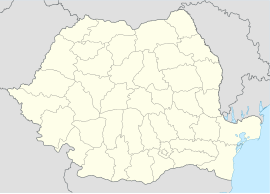Bocșa
This article needs additional citations for verification. (March 2013) |
Bocșa | |
|---|---|
 Town Hall | |
 Location in Caraș-Severin County | |
| Coordinates: 45°22′29″N 21°42′38″E / 45.37472°N 21.71056°E | |
| Country | Romania |
| County | Caraș-Severin |
| Government | |
| • Mayor (2021–2024) | Patriciu-Mirel Pascu[1] (PSD) |
Area | 122.02 km2 (47.11 sq mi) |
| Elevation | 159 m (522 ft) |
| Population (2021-12-01)[2] | 12,949 |
| • Density | 110/km2 (270/sq mi) |
| Time zone | EET/EEST (UTC+2/+3) |
| Postal code | 325300 |
| Vehicle reg. | CS |
| Website | www |
Bocșa (Romanian pronunciation: [ˈbokʃa] ; Template:Lang-hu; Template:Lang-de) is a town in Caraș-Severin County, in the Banat region of Romania, with a population of 12,949 in 2021.
Geography
The town is located in the southwestern part of Romania. The town has a length of 20.2 km (12.6 mi) and an area of approximately 675.9 ha (1,670 acres). It is located 80 km (50 mi) from Timișoara and 18 km (11 mi) from Reșița.[3] and is traversed by the national road DN58B, which connects Reșița to Voiteg, in Timiș County. Bocșa lies on the banks of the Bârzava River. To the east lie the Western Carpathian Mountains, offering a mountainous environment rich in natural resources, particularly iron, copper, and other non-ferrous minerals.[4] Directly to the east of Bocșa, the Pannonian Basin begins, featuring steppe-like landscapes.
History
Bocșa has a long-standing development dating back to the Neolithic era. It has seen continuous habitation through the Bronze Age and Iron Age, and during Roman times, it was a site for gold exploitation. First mentioned in a document in 1331, Bocșa has experienced various occupations, including Austro-Hungarian and Ottoman rule.[5] The town has a long tradition of mining, particularly for iron and copper. Mining activities date back to the 16th and 17th centuries under Turkish rule, where copper and iron were extracted. During the Habsburg period, Austrian miners revitalized the industry, establishing ironworks such as the "Altwerk" in 1719 and "Neuwerk" in 1722. These facilities processed iron ore from local sources, including the nearby Semenic Mountains and Lupac. The industrial development of Bocșa was further enhanced by the construction of a railway for industrial use in the 19th century and the establishment of a hydroelectric plant in 1896. Over time, the town transitioned to producing agricultural machinery, but mining remained a significant part of its economic history.[6] Bocșa also became a cultural and educational hub, with diverse religious institutions due to successive waves of colonization. Over time, it has developed a mixed demographic profile and remains an important regional center in Banat. [7]
Natives
- Nicolae Bocșan (1947–2016), historian
- Vasile Ciocoi (born 1976), footballer
- Sorin Frunzăverde (1960–2019), politician
- Ilona Kerekes (1926–2023), Hungarian international table tennis player
- Constantin Lucaci (1923–2014), sculptor
- Roco Sandu (born 1966), footballer
- Sándor Szurmay (1860–1945), Hungarian military officer and politician
Climate
Bocșa has a humid continental climate (Cfb in the Köppen climate classification).
| Climate data for Bocșa | |||||||||||||
|---|---|---|---|---|---|---|---|---|---|---|---|---|---|
| Month | Jan | Feb | Mar | Apr | May | Jun | Jul | Aug | Sep | Oct | Nov | Dec | Year |
| Mean daily maximum °C (°F) | 3.8 (38.8) |
5.9 (42.6) |
11.1 (52.0) |
16.8 (62.2) |
21.3 (70.3) |
24.6 (76.3) |
26.6 (79.9) |
26.9 (80.4) |
21.7 (71.1) |
16.6 (61.9) |
11.2 (52.2) |
4.9 (40.8) |
15.9 (60.7) |
| Daily mean °C (°F) | 0.2 (32.4) |
1.8 (35.2) |
6.3 (43.3) |
11.7 (53.1) |
16.3 (61.3) |
19.9 (67.8) |
21.8 (71.2) |
21.9 (71.4) |
17 (63) |
11.7 (53.1) |
6.9 (44.4) |
1.6 (34.9) |
11.4 (52.6) |
| Mean daily minimum °C (°F) | −3.1 (26.4) |
−2.1 (28.2) |
1.3 (34.3) |
6 (43) |
10.6 (51.1) |
14.3 (57.7) |
16.3 (61.3) |
16.4 (61.5) |
12.2 (54.0) |
7.2 (45.0) |
3.3 (37.9) |
−1.5 (29.3) |
6.7 (44.1) |
| Average precipitation mm (inches) | 57 (2.2) |
56 (2.2) |
61 (2.4) |
78 (3.1) |
82 (3.2) |
101 (4.0) |
81 (3.2) |
73 (2.9) |
74 (2.9) |
61 (2.4) |
57 (2.2) |
66 (2.6) |
847 (33.3) |
| Source: https://en.climate-data.org/europe/romania/caras-severin/bocsa-10735/ | |||||||||||||
| Year | Pop. | ±% |
|---|---|---|
| 1966 | 16,015 | — |
| 1977 | 20,731 | +29.4% |
| 1992 | 19,152 | −7.6% |
| 2002 | 19,023 | −0.7% |
| 2011 | 15,842 | −16.7% |
| 2021 | 12,949 | −18.3% |
| Source: Census data | ||
References
- ^ "Results of the 2021 local elections". Central Electoral Bureau. Retrieved 29 June 2021.
- ^ "Populaţia rezidentă după grupa de vârstă, pe județe și municipii, orașe, comune, la 1 decembrie 2021" (XLS). National Institute of Statistics.
- ^ "Istoric Bocșa" (PDF). Orasul Bocșa. Primăria Bocșa. Retrieved 15 August 2024.
- ^ "Istoric Bocșa" (PDF). Orasul Bocșa. Primăria Bocșa. Retrieved 15 August 2024.
- ^ "Istoric Bocșa" (PDF). Orasul Bocșa. Primăria Bocșa. Retrieved 15 August 2024.
- ^ "Geschichte des Bergbaus im Banater Bergland". Banater Berglanddeutsche. Retrieved 15 August 2024.
- ^ "Istoric Bocșa" (PDF). Orasul Bocșa. Primăria Bocșa. Retrieved 15 August 2024.



